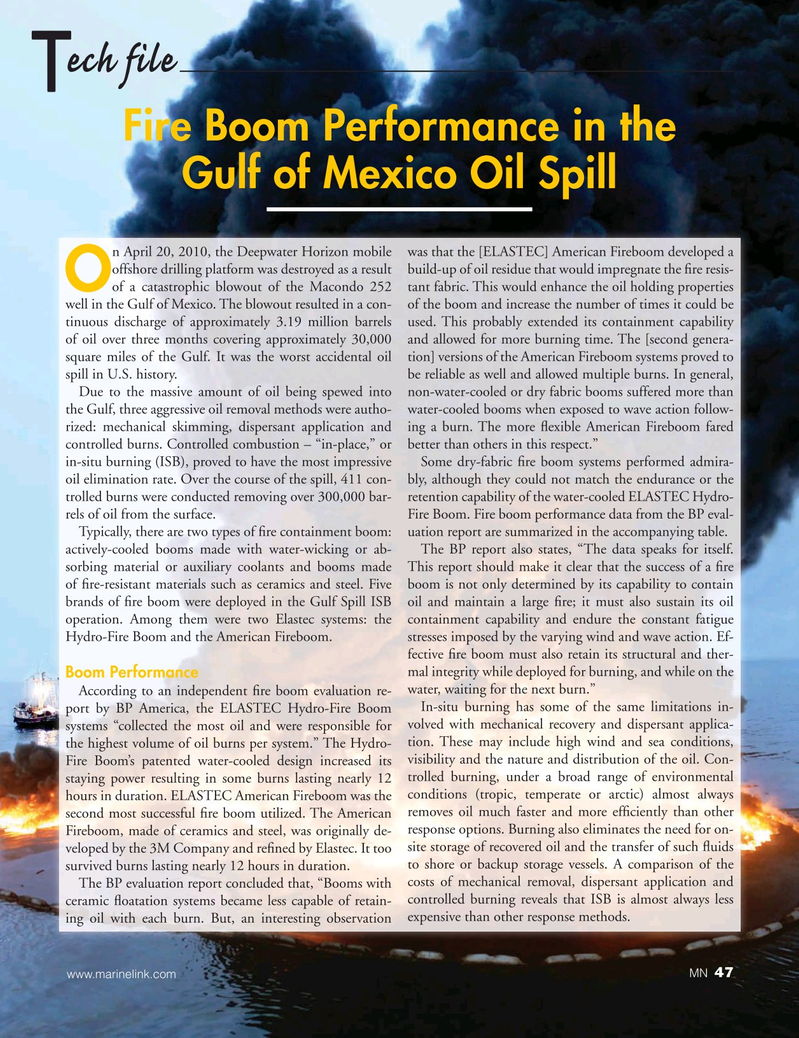
Page 47: of Marine News Magazine (June 2016)
Combat & Patrol Craft Annual
Read this page in Pdf, Flash or Html5 edition of June 2016 Marine News Magazine
ech file
T
Fire Boom Performance in the
Gulf of Mexico Oil Spill n April 20, 2010, the Deepwater Horizon mobile was that the [ELASTEC] American Fireboom developed a offshore drilling platform was destroyed as a result build-up of oil residue that would impregnate the ? re resis-
Oof a catastrophic blowout of the Macondo 252 tant fabric. This would enhance the oil holding properties well in the Gulf of Mexico. The blowout resulted in a con- of the boom and increase the number of times it could be tinuous discharge of approximately 3.19 million barrels used. This probably extended its containment capability of oil over three months covering approximately 30,000 and allowed for more burning time. The [second genera- square miles of the Gulf. It was the worst accidental oil tion] versions of the American Fireboom systems proved to spill in U.S. history. be reliable as well and allowed multiple burns. In general,
Due to the massive amount of oil being spewed into non-water-cooled or dry fabric booms suffered more than the Gulf, three aggressive oil removal methods were autho- water-cooled booms when exposed to wave action follow- rized: mechanical skimming, dispersant application and ing a burn. The more ? exible American Fireboom fared controlled burns. Controlled combustion – “in-place,” or better than others in this respect.” in-situ burning (ISB), proved to have the most impressive Some dry-fabric ? re boom systems performed admira- oil elimination rate. Over the course of the spill, 411 con- bly, although they could not match the endurance or the trolled burns were conducted removing over 300,000 bar- retention capability of the water-cooled ELASTEC Hydro- rels of oil from the surface. Fire Boom. Fire boom performance data from the BP eval-
Typically, there are two types of ? re containment boom: uation report are summarized in the accompanying table.
actively-cooled booms made with water-wicking or ab- The BP report also states, “The data speaks for itself. sorbing material or auxiliary coolants and booms made This report should make it clear that the success of a ? re of ? re-resistant materials such as ceramics and steel. Five boom is not only determined by its capability to contain brands of ? re boom were deployed in the Gulf Spill ISB oil and maintain a large ? re; it must also sustain its oil operation. Among them were two Elastec systems: the containment capability and endure the constant fatigue
Hydro-Fire Boom and the American Fireboom. stresses imposed by the varying wind and wave action. Ef- fective ? re boom must also retain its structural and ther- mal integrity while deployed for burning, and while on the
Boom Performance water, waiting for the next burn.”
According to an independent ? re boom evaluation re-
In-situ burning has some of the same limitations in- port by BP America, the ELASTEC Hydro-Fire Boom systems “collected the most oil and were responsible for volved with mechanical recovery and dispersant applica- tion. These may include high wind and sea conditions, the highest volume of oil burns per system.” The Hydro-
Fire Boom’s patented water-cooled design increased its visibility and the nature and distribution of the oil. Con- staying power resulting in some burns lasting nearly 12 trolled burning, under a broad range of environmental hours in duration. ELASTEC American Fireboom was the conditions (tropic, temperate or arctic) almost always second most successful ? re boom utilized. The American removes oil much faster and more ef? ciently than other response options. Burning also eliminates the need for on-
Fireboom, made of ceramics and steel, was originally de- veloped by the 3M Company and re? ned by Elastec. It too site storage of recovered oil and the transfer of such ? uids to shore or backup storage vessels. A comparison of the survived burns lasting nearly 12 hours in duration.
The BP evaluation report concluded that, “Booms with costs of mechanical removal, dispersant application and controlled burning reveals that ISB is almost always less ceramic ? oatation systems became less capable of retain- ing oil with each burn. But, an interesting observation expensive than other response methods.
47 www.marinelink.com MN
MN June16 Layout 32-49.indd 47 5/17/2016 10:44:59 AM

 46
46

 48
48
